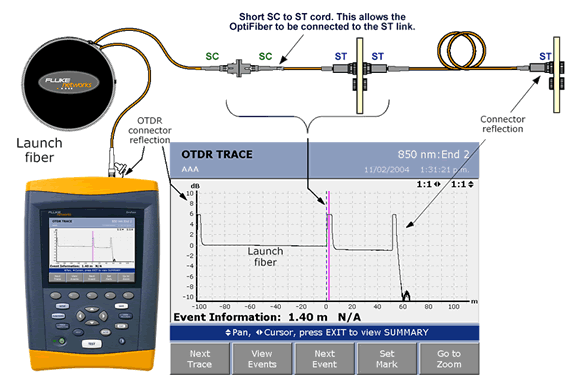Launch Leads - OptiFiber
| Lets kick off by saying that you cannot add a short jumper at the end of the launch lead. Users try and do this if the link they are testing has a different connector type to that of the launch lead. An example of this incorrect practice is shown below:
The OptiFiber is smart enough to know that there is an event there. Problem is that it is hidden. What appears as one event to the eye is actually two events. The loss measured at this point will be both the end of the launch lead AND the first connector of the link. When you look at the event table in OptiFiber for this example, you see that the OptiFiber identifies the launch event but fails to measure the first connection of the link under test.
The solution is to have a launch lead that has the appropriate connector type at the end. In most cases, this will mean making a number of launch leads to accommodate this. Recommended Launch Lead Lengths
Recommended Receive Fiber Lengths
Additional Information (Technical) This issue is related to dead zones. To measure loss, the instrument must be able to measure the backscatter. The Telcordia Attenuation Dead zone specifies the distance after an event needed before the signal settles down to within 0.5 dB of the actual backscatter level. Additional distance is needed before the signal settles down to level closer to the backscatter, hence the single-mode launch fiber length of 130m when the attenuation dead zone for the widest pulse width is only 107m. The attenuation dead zones are listed below for the various pulse widths. Add at least 30m to the attenuation dead zone for measuring backscatter. Note that the worse the connection, the wider the dead zone will be, so the longer the fiber needs to be to measure backscatter.
A very short hybrid patch cable, say less than 0.5m, won't be detected as a hidden event. Unfortunately, you are still measuring the loss of the extra connector - not what you want to do for premises testing. The critical part is that the fiber prior to the fiber under test (and after if using a receive fiber) is more than the attenuation dead zone. I saw this specified in the ballot for the new revision of the ISO/IEC 14763-3 standard for premises fiber installation (not sure if the original standard specified or not). |









